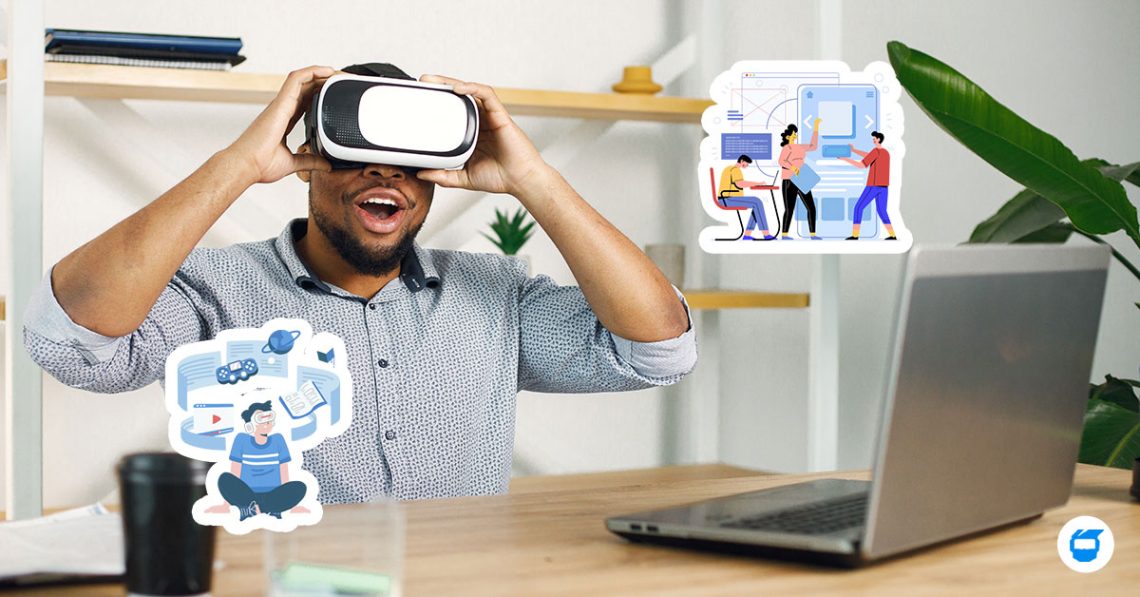Virtual Reality (VR) has moved from the realm of science fiction into our everyday lives, offering immersive experiences through 3D environments. But how does VR intersect with web development? Let’s dive into what VR is and its growing influence in the web development landscape.

Table of Contents
- What is Virtual Reality?
- How Does VR Work?
- The Role of VR in Web Development
- Tools and Frameworks for VR Web Development
- The Future of VR in Web Development
- Challenges
What is Virtual Reality?
Virtual Reality (VR) is a technology that creates a simulated 3D environment where users can interact as if they were physically present. Users are transported into a virtual space by using VR headsets and other sensory equipment, making the experience highly immersive and engaging.
How Does VR Work?
VR operates by generating a convincing 3D environment using advanced graphics, audio, and other sensory stimuli. A VR headset covers the user’s eyes and uses stereoscopic displays to create depth, while head tracking technology adjusts the user’s view in real-time, making the virtual environment feel incredibly real.
The Role of VR in Web Development
1. Enhancing User Experience with VR
One of the primary impacts of VR in web development is the enhancement of user experience. Traditional websites are often limited to text, images, and videos. However, VR transforms these static experiences into interactive 3D environments. For example, imagine visiting a website where you can walk through a virtual store, examine products in 3D, and interact with them before making a purchase. This level of interactivity can significantly boost user engagement and satisfaction.
2. Virtual showrooms in Ecommerce with VR
E-commerce is experiencing a revolution with VR technology. Virtual showrooms allow customers to explore products in a detailed 3D environment, providing a realistic sense of scale and detail. This can be particularly beneficial for sectors like real estate, where potential buyers can take virtual tours of properties, or the automotive industry, where customers can inspect vehicles in a virtual showroom.
3. Remote Collaboration and Training in VR
VR is also transforming remote collaboration and training. For web developers, this means new tools and platforms for working together in a virtual space. Teams can meet in a virtual office, brainstorm ideas on a virtual whiteboard, or work on a project in a shared 3D environment. This can enhance productivity and foster a sense of presence that traditional video calls can’t match.
4. WebVR: Bringing VR to Web Browsers
WebVR is an open standard that allows users to experience VR in a web browser, eliminating the need for special apps or software. Web developers can create VR experiences that run directly in the browser, making them easily accessible to anyone with a VR headset.
Advantages of WebVR
- Accessibility: Users don’t need to download or install additional software.
- Cross-Platform Compatibility: Works across different devices and operating systems.
- Ease of Development: Utilizes existing web technologies like HTML, CSS, and JavaScript.
Tools and Frameworks for VR Web Development
Several tools and frameworks facilitate the creation of VR experiences for the web:
1. A-Frame
A-Frame is an open-source web framework designed to make building VR experiences easy, especially for those familiar with HTML. It simplifies the process of creating 3D environments and adding interactive elements, making it accessible for web developers of all skill levels.
2. React 360
React 360 is a powerful library that allows developers to build VR applications using React. It combines the declarative nature of React with the capabilities of WebGL, enabling the creation of complex and interactive VR experiences.
3. Three.js
Three.js is a popular JavaScript library that helps developers create and display 3D graphics in the browser. It’s highly versatile and can be used for a wide range of applications, including VR. Three.js provides a rich set of features for building detailed and interactive 3D environments.
The Future of VR in Web Development
1. Increasing Adoption and Innovation
As VR technology continues to advance, its adoption in web development is expected to grow. New hardware and software innovations will make VR more accessible and affordable, encouraging more developers to explore this exciting technology.
2. Integration with Emerging Technologies
VR is likely to integrate with other emerging technologies, such as Augmented Reality (AR), Artificial Intelligence (AI), and the Internet of Things (IoT). This integration can lead to more immersive and intelligent web experiences. For instance, AI could create more realistic virtual environments, while IoT could enable real-time interactions with physical devices.
Challenges
Despite its potential, it’s essential to bear in mind that there are still some challenges to widespread VR adoption in web development, including:
1. Technical Limitations
One major challenge is the significant computing power required to run VR experiences smoothly. Not all devices, especially older or less powerful ones, can handle the demanding graphics and processing needs of VR, which can result in a poor user experience.
2. User Accessibility
Another hurdle is user accessibility. While VR headsets are becoming more affordable, they are still not commonplace. This limits the potential audience for VR web content, as many users do not have the necessary equipment to engage with these experiences.
3. Development Complexity
Creating VR content is often more complex and time-consuming than traditional web development. Developers need to learn new tools and frameworks, and the process of designing and optimizing 3D environments can be challenging. This can be a significant barrier for developers who are new to VR.
Virtual Reality is no longer a futuristic concept but a powerful tool transforming web development. As technology continues to evolve, the role of VR in web development is likely to expand, paving the way for even more immersive and interactive online experiences.
Looking for web design services for your business? Contact us today, and we’ll be glad to assist you!

